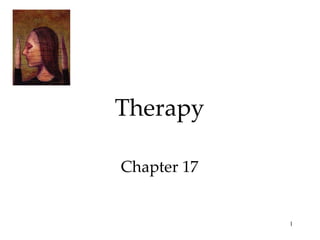
Chapter17
- 5. History of Insane Treatment Maltreatment of the insane throughout the ages was the result of irrational views. Many patients were subjected to strange, debilitating, and downright dangerous treatments. The Granger Collection The Granger Collection
- 6. History of Insane Treatment Philippe Pinel in France and Dorthea Dix in America founded humane movements to care for the mentally sick. http://wwwihm.nlm.nih.gov Philippe Pinel (1745-1826) Dorthea Dix (1745-1826) Culver Pictures
- 7. Therapies Psychotherapy involves an emotionally charged, confiding interaction between a trained therapist and a mental patient. Biomedical therapy uses drugs or other procedures that act on the patient’s nervous system, curing him or her of psychological disorders. An eclectic approach uses various forms of healing techniques depending upon the client’s unique problems.
- 29. Cognitive Therapy for Depression Rabin et al., (1986) trained depressed patients to record positive events each day, and relate how they contributed to these events. Compared to other depressed patients, trained patients showed lower depression scores.
- 30. Stress Inoculation Training Meichenbaum (1977, 1985) trained people to restructure their thinking in stressful situations. “ Relax, the exam may be hard, but it will be hard for everyone else too. I studied harder than most people. Besides, I don’t need a perfect score to get a good grade.”
- 32. Group Therapy Group therapy normally consists of 6-9 people attending a 90-minute session that can help more people and costs less. Clients benefit from knowing others have similar problems. © Mary Kate Denny/ PhotoEdit, Inc.
- 33. Family Therapy Family therapy treats the family as a system. Therapy guides family members toward positive relationships and improved communication.
- 35. Evaluating Psychotherapies Within psychotherapies cognitive therapies are most widely used, followed by psychoanalytic and family/group therapies.
- 42. Evaluating Alternative Therapies Lilienfeld (1998) suggests comparing scientific therapies against popular therapies through electronic means. The results of such a search are below:
- 52. Double-Blind Procedures To test the effectiveness of a drug, patients are tested with the drug and a placebo. Two groups of patients and medical health professionals are unaware of who is taking the drug and who is taking the placebo.
- 53. Schizophrenia Symptoms Appropriate symptoms absent (negative symptoms) Inappropriate symptoms present (positive symptoms) Apathy, expressionless faces, rigid bodies. Hallucinations, disorganized thinking, deluded ways.
- 61. Psychosurgery Psychosurgery was popular even in Neolithic times. Although used sparingly today, about 200 such operations do take place in the US alone. http://www.epub.org.br
- 63. Psychosurgery Modern methods use stereotactic neurosurgery and radiosurgery (Laksell, 1951) that refine older methods of psychosurgery. http://www.epub.org.br http://www.epub.org.br
- 64. Preventing Psychological Disorders “ It is better to prevent than cure.” Peruvian Folk Wisdom Preventing psychological disorders means removing the factors that affect society. Those factors may be poverty, meaningless work, constant criticism, unemployment, racism, and sexism.
- 65. Psychological Disorders are Biopsychosocial in Nature
Notas del editor
- OBJECTIVE 1 | Contrast psychotherapy and the biomedical therapies, and explain how an eclectic approach or psychotherapy integration varies from either of these two main forms of therapy.
- OBJECTIVE 2 | Define psychoanalysis , and discuss the aims of this form of therapy.
- OBJECTIVE 3 | Describe some of the methods used in psychoanalysis, and list some criticisms of this form of therapy.
- OBJECTIVE 4 | Contrast psychodynamic therapy and interpersonal therapy with traditional psychoanalysis.
- OBJECTIVE 5 | Identify the basic characteristics of the humanistic therapies, and describe the specific goals and techniques of Carl Rogers’ client-centered therapy.
- OBJECTIVE 6 | Explain how the basic assumption of behavior therapy differs from those of traditional psychoanalytic and humanistic therapies.
- OBJECTIVE 7 | Define counterconditioning , and describe the techniques used in exposure therapies and aversive conditioning.
- OBJECTIVE 8 | State the main premise of therapy based on operant conditioning principles, and describe the views of proponents and critics of behavior modification.
- OBJECTIVE 9 | Contrast cognitive therapy and cognitive-behavior therapy, and give some examples of cognitive therapy for depression.
- OBJECTIVE 10 | Discuss the rationale and benefits of group therapy, including family therapy.
- OBJECTIVE 11 | Explain why clients tend to overestimate the effectiveness of psychotherapy.
- OBJECTIVE 12 | Give some reasons why clinicians tend to overestimate the effectiveness of psychotherapy, and describe the phenomena that contribute to clients’ and clinicians’ misperceptions of this area.
- OBJECTIVE 13 | Discuss the importance of outcome studies in judging the effectiveness of psychotherapies, and describe some of these findings.
- OBJECTIVE 14 | Summarize the findings on which psychotherapies are most effective for specific disorders.
- OBJECTIVE 15 | Evaluate the effectiveness of eye movements desensitization and reprocessing (EMDR) and light exposure therapies.
- OBJECTIVE 16 | Describe the three benefits attributed to all psychotherapies.
- OBJECTIVE 17 | Discuss the role of values and cultural differences in the therapeutic process.
- OBJECTIVE 18 | Define psychopharmacology, and explain how double-blind studies help researchers evaluate a drug’s effectiveness.
- OBJECTIVE 18 | Define psychopharmacology, and explain how double-blind studies help researchers evaluate a drug’s effectiveness.
- OBJECTIVE 19 | Describe the characteristics of antipsychotic drugs, and discuss their use in treating specific disorders.
- OBJECTIVE 20 | Describe the characteristics of antianxiety drugs, and discuss their use in treating specific disorders.
- OBJECTIVE 21 | Describe the characteristics of antidepressant drugs, and discuss their use in treating specific disorders.
- OBJECTIVE 22 | Describe the use and effects of mood-stabilizing medications.
- OBJECTIVE 23 | Describe the use of electroconvulsive therapy (ECT) in treating severe depression, and describe some possible alternatives to ECT.
- OBJECTIVE 24 | Summarize the history of the psychosurgical procedure known as lobotomy, and discuss the use of psychosurgery today.
- OBJECTIVE 25 | Explain the rationale of preventive mental health programs, and discuss how this viewpoint illustrates the biopsychosocial perspective in psychology.